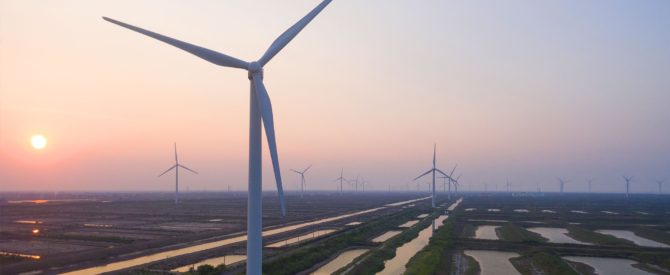Asia-Pacific continued to lead in global wind power development in 2019, accounting for 50.7 percent of 60,000 megawatts of global new installations, boosted by regulatory reform during the past two years, according to a report by the Global Wind Energy Council.
Trailing were Europe at 25.5 percent, North America with 16.1 percent, Latin America at 6.1 percent and Africa and the Middle East with 1.6 percent.
The 60,000 MW brought global total installed capacity to 650,000 MW, up 10 percent from 2018.
Among individual countries, China was the global leader in new wind power installations in 2019 at almost 23,800 MW, accounting for 43.3 percent. This brought the country’s total installed capacity up to more than 205,800 MW. India was fourth in new installations, accounting for almost 2,380 MW, or just under 4 percent of the global total last year.
Asia Pacific was the global leader for new onshore wind installations in 2019, installing 28,100 MW of new capacity, more than half of total new global capacity. Emerging markets for wind in Africa, the Middle East, Latin America and South East Asia also showed moderate growth in 2019, with combined installations of 4,500 MW.
At the country level – as the world’s largest wind market – China grid-connected 23,800 MW of onshore wind last year, boosting its total onshore installations to 230,000 MW. “China’s onshore has gone through a crucial period of regulatory reform in the past two years,” the council said in its report. “The Chinese government introduced an auction scheme in 2018 and a year later the National Development and Reform Commission released a new policy “presenting a clear roadmap towards ‘subsidy-free’ onshore wind.” The “subsidy-free” term is generally used to refer to wind energy installations not supported by government subsidies.
According to the World Bank Group, renewable energy auctions are also known as “demand auctions” or “procurement auctions,” under which the government issues a call for tenders to install a certain capacity of renewable energy-based electricity. Project developers who participate in the auction submit a bid with a price per unit of electricity at which they are able to complete the project. The government evaluates the offers on the basis of the price and other criteria and signs a power purchasing agreement with the successful bidder.
China led in the off shore wind energy category last year, with 2,400 MW installed in 2019 or almost 38 percent of global installations last year. China accounted for nearly 95 percent of Asia-Pacific’s installed off shore wind energy last year, with South Korea and other Asia countries account for the remainder.
“Established market players such as China and the U.S. accounted for nearly 60 per cent of new installations, however, we see emerging markets in regions such as South East Asia, Latin America and Africa playing an increasingly important role in the years to come, while offshore wind is also becoming a significant growth driver,” Ben Backwell, CEO of the council, said in a news release.
The council said it expects Southeast Asia to play an increasingly important role in driving wind power growth, if the right market frameworks and ambition are in place. Markets cited as ones to watch in the region include Vietnam and Thailand.
Although Vietnam had a small amount of new wind energy installation last year – 160 MW – that’s up 400 percent from 32 MW in 2018, for total installations of 228 MW.
The organization notes that Vietnam’s wind industry still faces competition from government subsidized coal. “The biggest obstacle for wind is the high cost of capital and lack of financing for projects, with persisting risk factors in relation to the [power purchase agreement] continuing to deter international developers and lenders,” the council said. Non-recourse finance is commercial lending that entitles the lender to repayment only from the profits of the project the loan is funding.
A transparent and replicable project-approval process would also help bring down costs and encourage more firms to develop and invest in wind energy projects in Vietnam, according to the report.
The council noted respectable progress for Thailand last year, with 322 MW of new installations bringing its total wind installations to more than 1,500 MW, half of the 3,000 MW target set by the government for 2037. The commissioning of Energy Absolute’s 250 MW Hanuman wind project – consisting of five wind farms in Chaiyaphum Province – was responsible for most of the total capacity.
The organization said it believes the fundamental issue for Thailand is the country’s reliance on domestic natural gas. “The Thai government prioritizes gas for the security of supply and cost reasons and gives this strategy pre-eminence over issues of sustainability and environment,” the council stated in the report. “Thus, it is critical that the wind sector is able to strengthen its policy advocacy and show how large-scale wind together with other renewable sources can provide a reliable and cost-effective alternative to gas.”

Wind turbines at a coastal wind energy farm in Nantong, China. The Global Wind Energy Council said in its 2019 report that the Asia Pacific region was the global leader for new onshore wind installations in 2019, installing 28.1 gigawatts of new capacity, more than half of the total new global capacity.